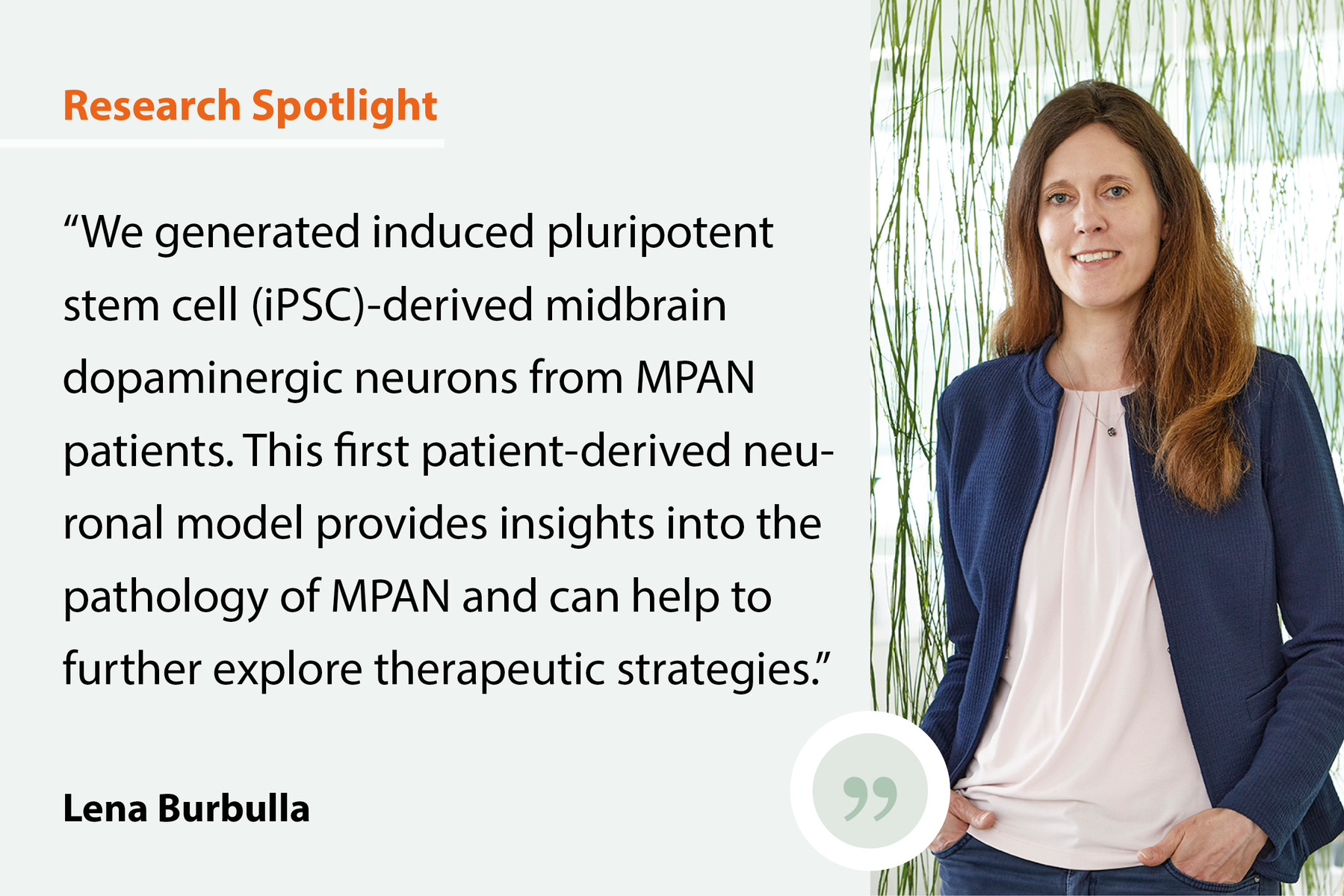"Research Spotlight"
Ein Überblick über die wichtigsten Veröffentlichungen, mit kurzen Zusammenfassungen und Kommentaren der Autoren.
Publication in Science Translational Medicine, 2025
Using PET-imaging to detect cortical synapse loss in multiple sclerosis
The standard method for diagnosing multiple sclerosis (MS) is magnetic resonance imaging (MRI), which primarily identifies damage to the brain's white matter. However, synapse loss in gray matter is a more important indicator of disease progression. A team of researchers has discovered a method to utilize positron emission tomography (PET) for detecting and monitoring synapse loss in gray matter by targeting the synaptic protein SV2A.
Publication in Movement Disorders, 2025
First patient-derived neuronal model of MPAN
Mitochondrial membrane protein-associated neurodegeneration (MPAN) is a rare neurodegenerative disorder marked by increased levels of α-synuclein, iron deposits, and axonal damage in the brain. Researchers have now created the first neuronal model of the disease derived from patient cells, aimed at uncovering the specific mechanisms that drive this condition.
Publication in Nature Structural & Molecular Biology, 2025
Structure of a risk factor for Alzheimer’s elucidated: Clusterin
Individuals who carry risk alleles of the clusterin gene have a higher likelihood of developing late-onset Alzheimer's disease. To gain a deeper understanding of the associated protein's function, researchers have deciphered the molecular basis of clusterin’s chaperone activity. For the first time, they determined the three-dimensional crystallographic structure of human clusterin – revealing that two disordered, hydrophobic peptide tails are essential for its diverse binding and protective functions.
Publication in Molecular Neurodegeneration, 2025
Alzheimer’s: The effect of long-term anti-amyloid-β immunotherapy
Anti-amyloid-β immunotherapy is currently the only disease-modifying treatment for patients showing early symptoms of Alzheimer's disease. This treatment approach is known to depend at least in part on microglial activity. Researchers therefore studied the effects of long-term immunotherapy on these cells. They found that aggregated amyloid-β was removed and plaques were reduced, while microglial activation remained high around the residual plaques, providing important insights for chronic treatment strategies.
Publication in Nature Cardiovascular Research, 2025
Lower interleukin-6 activity reduces risk of cardiovascular diseases
Atherosclerotic cardiovascular disease is the leading cause of death worldwide. Researchers now found that lowering the activity of interleukin-6 – a key immune signal regulating inflammatory responses in the body – could reduce the risk of cardiovascular disease without making people more vulnerable to infections.
Publication in Nature Communications, 2025
Alzheimer's: Early onset of smelling issues linked to immune response.
A reduced sense of smell can be one of the first signs of Alzheimer's disease, often appearing before cognitive impairments are noticeable. Researchers have discovered that the brain's immune system plays a significant role, indicating that it may attack neuronal fibers essential for the sense of smell. These findings could lead to earlier diagnosis and treatment options.
Publication in Nature Communications, 2025
Neuronal remodeling is driven by polyglutamylation
The brain removes unnecessary or weak synaptic connections. A team of researchers has discovered that tubulin polyglutamylation is crucial for this synaptic remodeling because it tags microtubules for severing. This new study reinforces a connection between the remodeling of neurites during development and the degeneration of axons in disease.
Publication in Nature Neuroscience, 2025
Aging-related neurodegeneration: Microglia activation leads to the accumulation of CD8+ T cells
Aging is associated with structural and functional changes in the white matter of the brain, which can lead to neurodegeneration. In a new study, researchers investigated aging-related changes in white matter and found that the maladaptive activation of microglia leads to the recruitment of harmful CD8+ T cells.
Publication in Nature Communications, 2025
The survival of stable place cells is predictive of a good cognitive outcome after stroke
Cognitive decline is common following a stroke, but the underlying mechanisms are not well understood. A team of researchers have uncovered the role of place cells, and how a functional subclass of them are predictors of cognitive outcome after stroke.
Publication in Molecular Neurodegeneration, 2025
Alpha-Synuclein accelerates Aβ-driven tau accumulation and cognitive decline in Alzheimer’s disease
A new study reveals that the protein α-Synuclein is more prevalent in advanced Alzheimer’s disease and that it accelerates amyloid-related tau accumulation. These findings show the need to consider α-synuclein in Alzheimer’s research and treatment strategies.
Publication in Nature Communications, 2025
MIF-2: An atypical chemokine connecting vascular inflammation to metabolic dysfunction in atherosclerosis
Atherosclerotic cardiovascular diseases, including myocardial infarction and ischemic stroke, are the leading cause of mortality worldwide. A team of researchers shows that the protein MIF-2/D-DT acts as an atypical chemokine and a non-cognate ligand of CXCR4, which helps promote the development of atherosclerosis and inflammation in blood vessels. The study improves our understanding of how inflammation in blood vessels is connected to liver problems in atherosclerotic diseases and points out potential treatment pathways.
Publication in Science Translational Medicine, 2025
Alzheimer’s disease: Amyloid drives the spread of tau by evoking neuronal hyperconnectivity
The Amyloid Cascade model of Alzheimer’s disease suggests that plaques of amyloid-β (Aβ) are the primary cause of the disease and trigger other pathological changes, such as the spread of abnormal tau protein. The exact connection between amyloid and tau buildup is not clear. Researchers now found an essential piece to this puzzle: by analyzing PET and MRI imaging, they show that amyloid drives the spread of tau by evoking neuronal hyperconnectivity.
Publication in Immunity, 2025
The HDAC9 risk locus controls inflammasome activation in atherosclerosis
The accumulation of amyloid-β plaques is known to initiate a pathological cascade that leads to neurodegeneration and dementia. How these plaques are formed is only partially understood. Here, we provide evidence that aggregation of Apolipoprotein E (APOE) together with amyloid-β within the lysosomal system of microglia may trigger the generation of amyloid-β plaques.
Publication in Immunology, 2024
Apolipoprotein E aggregation in microglia initiates Alzheimer’s disease pathology by seeding β-amyloidosis
The accumulation of amyloid-β plaques is known to initiate a pathological cascade that leads to neurodegeneration and dementia. How these plaques are formed is only partially understood. Here, we provide evidence that aggregation of Apolipoprotein E (APOE) together with amyloid-β within the lysosomal system of microglia may trigger the generation of amyloid-β plaques.
Publication in Cell Reports, 2024
Extracellular vesicles facilitate cellular communication and play key role in the development of the brain
Researchers conducted a study on extracellular vesicles (EVs), which are vesicles that transport bioactive molecules and deliver them to recipient cells in the brain. They have discovered that these vesicles facilitate specialized communication between different types of cells. These findings emphasize the crucial role of EVs in brain development and could potentially lead to new therapeutic approaches for treating neurological diseases in the future.
Publication in Science Immunology, 2024
MS TWIN uncovers role of CD8 T cells in early stages of multiple sclerosis
Researchers have compared a type of immune cells (CD8 T cells) of monozygotic twin pairs, where one twin has MS while the other shows no signs or subclinical signs of neuroinflammation. They found specific changes indicating that CD8-positive T cells play a crucial role in the early stages of multiple sclerosis. These findings can potentially open up new therapeutic avenues and could be used to develop improved diagnostic methods.
Publication in Alzheimer’s & Dementia, 2024
New biomarker algorithm for detecting 4-repeat tauopathies
Researchers from Ludwig-Maximilians-Universität (LMU) Munich, in collaboration with Monash University Melbourne, have developed a novel biomarker algorithm that differentiates rare primary 4-repeat-tauopathies from Alzheimer’s disease with unprecedented precision. This innovative approach, which combines cerebrospinal fluid analysis with PET imaging, offers new insights into disease mechanisms and paves the way for advanced clinical trials.
Publication in Immunity, 2024
Remyelination in the aged CNS activated by training the immune system
The central nervous system's decreased ability to regenerate as we age limits its ability to recover after demyelinating injuries, such as MS lesions. Researchers have now discovered that through training the immune system inactive microglia can be reprogrammed, restoring their ability to repair neuronal lesions.
Publication in Nature, 2024
Mechanisms underlying recurrent atherosclerotic stroke uncovered
Recurrent strokes in the days and weeks after the initial event are a common problem in patients whose original cause was arteriosclerosis. An international team of researchers has uncovered the mechanisms underlying this process and proposed a new therapy involving DNase enzymes to break down cell-free DNA. If confirmed in humans, these findings could lead to improved stroke therapy.
Publication in Cell, 2024
Stroke triggers epigenetic changes in immune system
A stroke not only causes immediate damage to the brain, but it can also have long-term health effects on other organs, such as the heart. In a recent study published in Cell, researchers demonstrate that persistent pro-inflammatory changes in myeloid cells after stroke play a direct role in the development of cardiac fibrosis, independent of other factors that can lead to cardiovascular issues.
Publication in Nature Communications, 2024
Correcting mutations that cause hereditary stroke
Researchers have established three strategies to repair the function of mutant proteins causing CARASIL – a rare, genetic form of cerebral arteriopathy that leads to early-onset stroke and dementia. Their findings open perspectives for targeted protein repair.
Publication in Nature Neuroscience, 2024
Amyloidosis triggers age-related oligodendrocyte and myelin damage
Age-related myelin damage leads to white matter inflammation, but its impact on chronic neurodegenerative diseases remains unclear. A recent study reveals that amyloidosis alone can cause age-related oligodendrocyte and myelin damage in mouse models of Alzheimer's disease. The research team discovered that CD8 T cells contribute to neurodegenerative diseases associated with amyloidosis by abnormally activating microglia, resulting in myelin damage.
Publication in Nature Neuroscience, 2024
Key mechanisms identified for improving astrocyte-to-neuron reprogramming
Researchers have made significant progress in unraveling novel mechanisms of glia-to-neuron conversion. Using novel methods in epigenome profiling, they identified that a posttranslational modification of the reprogramming neurogenic transcription factor profoundly impacts epigenetic rewiring and the improvement in neuronal programming. They identified a novel protein as key player in this conversion process, namely the transcriptional regulator YingYang1 that physically interacts with the neurogenic factor to open up the chromatin.
Publication in Nature Aging, 2024
How the protein composition of brain endothelial cells changes with aging
Brain endothelial cells are critical components of the blood-brain barrier. They safeguard the central nervous system and their dysfunction is related to neurodegenerative diseases. Researchers have analyzed how the proteome of brain endothelial cells changes as we age, offering important insights into brain health.
Publication in Nature Metabolism, 2024
A mechanistic connection between insulin resistance and mitochondrial dysfunction
There is growing evidence that problems with insulin signaling play an important role in the development of neurodegenerative disease, but its exact mechanisms remain unclear. Researchers in a new study focusing on mitochondrial quality control identified a metabolic switch suggesting a mechanistic connection between insulin resistance and mitochondrial dysfunction.
Publication in Nature, 2024
B cells promote tolerance against the neuromyelitis optica autoantigen AQP4
In patients with neuromyelitis optica (NMO), an autoimmune disorder of the central nervous system (CNS), the immune system erroneously targets the AQP4 protein through the action of antibodies and T cells. Researchers have now uncovered the role of B cells in the thymus gland in this disease: these cells play a pivotal role in instructing T cells on their target for attack.
Publication in eBioMedicine, 2024
MiniSWINE: a minipig model of demyelinating brain diseases
Researchers developed a new way to research inflammatory demyelinating diseases using minipigs. Their method is called miniSWINE: Minipig Stereotactic White-matter Injection using Navigation by Electromagnetism. Their method successfully models the changes observed in demyelinating and remyelinating lesions in human patients' brain. It can thus help to develop better diagnostic tools and treatments for diseases like multiple sclerosis.
Publication in Nature Communications, 2024
Changes in synapses related to protein 43 (GAP-43) speed up the spread of tau in Alzheimer’s disease
A combined neuroimaging and biofluid biomarker study investigated whether synaptic changes are associated with accelerated tau spreading in Alzheimer’s disease (AD). They found that higher levels of the presynaptic protein GAP-43 speed up the spread of tau in AD. These findings are relevant for developing treatments to slow down the progression of the disease.
Publication in Neuron, 2024
Replacing lost neurons: Influence of dysfunctional mitochondria on direct neuronal reprogramming uncovered
Mitochondria account for essential cellular processes – from energy production (ATP) to nucleotide metabolism. Dysfunction of mitochondria can lead to neurological disorders and contribute to developing diseases associated with aging. Researchers have now uncovered the role of dysfunctional mitochondria in direct neuronal reprogramming.
Publication in Nature Medicine, 2023
Greater plasticity than expected: Astrocytes proliferate and acquire neural stem cell properties after brain injury
Glial cells play an important role in brain injuries; they can support brain function and react to the injury. Researchers found that astrocytes, a specific type of glial cells, proliferate and acquire neural stem cell properties after brain injury.
Publication in Science Translational Medicine, 2023
A new therapeutic approach for atherosclerosis: the role of CXCR4 & microRNA
The chemokine receptor CXCR4 in vascular smooth muscle cells and endothelial cells has a protective function for vessels. Researchers found a microRNA molecule that can regulate CXCR4, offering a promising starting point for new therapies.
Publication in Neurology, 2023
Parkinson’s patients can benefit from a change of treatment when treatment options are exhausted
As Parkinson's progresses, more invasive therapies are used – for example, deep brain stimulation or pump therapies. When these no longer yield results, physicians often conclude that treatment options are exhausted. However, new research shows that such patients can still benefit from a change in treatment.
Publication in Annals of Neurology, 2023
A genetic risk variant for multiple sclerosis severity is associated with brain atrophy
In a recent large study, researchers found two genes associated with MS disease progression. A new study now shows that one of these genes is associated with a loss of neurons and connections between neurons: people with this gene experienced 28% more brain shrinkage than those without it.
Publication in The Lancet, 2023
The effect of antihypertensive drugs on small vessel disease
Results from a clinical trial show that different blood pressure medications have differential effects on the microvascular function in people with small vessel disease. The researchers found no differences for patients with sporadic small vessel disease but did find that two specific drugs resulted in improved function of cerebral blood vessels in patients diagnosed with CADASIL (cerebral autosomal dominant arteriopathy with subcortical infarcts and leukoencephalopathy) when compared to another antihypertensive drug.
Publication in The Lancet, 2023
Decoding PET signals in brain tumors at the cellular level
A new method makes the signals of radioactive tracers in cells in the brain visible using positron emission tomography (PET). The method and its results are of great importance for the diagnosis and therapy development of brain tumors as well as for neurological diseases in general.


































